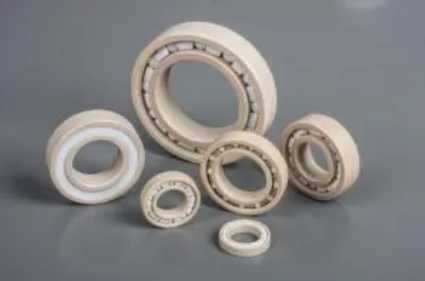Welcome to Sino Bearings web
24x7 HOTLINE:+86-28-81454188

 TECHNOLOGY
TECHNOLOGY
Steel has long reigned supreme in the bearing world, but thanks to advances in material science, plastic bearings have evolved well beyond the standard injection-molded nylon bearings of times gone by. Polytetrafluoroethylene (PTFE), polyvinylidene difluoride (PVDF), polyether ether ketone (PEEK), along with high-performance polymers, offer wider possibilities than ever before. But are they suitable for high-load applications? Here Chris Johnson, managing director of plastic bearing supplier SMB Bearings, explains how to assess load ratings for bearings.
When calculating bearing life, it is important to consider load ratings. These are a measure of how quickly the rotating elements of a bearing will experience fatigue and the total number of revolutions a bearing can withstand before it fails. These ratings can be categorized into static load ratings and dynamic load ratings.
A typical radial ball bearing, which is designed primarily for radial loads, has a maximum static and dynamic load capacity. The static load capacity is the maximum radial load that a bearing can withstand before the load causes a total, permanent deformation of the bearing balls or the raceway equal to one ten thousandth of the ball’s diameter.
While 3D printed high-performance thermoplastics such as carbon fiber and PEEK offer a promising alternative to metal, plastics are often not considered a viable choice by design engineers as they are weaker than metal. So, can plastic bearings support high loads?
Before delving into this question deeper, it’s important to establish what is meant by heavy loads. The definition or understanding of high loads can actually vary depending on the application. It makes sense that a high load for a wheel hub bicycle bearing isn’t comparable to a high load for a bearing used in an MRI scanner, so it’s important to look beyond this requirement and consult the datasheet for your component.
Load ratings are a guide to the maximum load that a bearing can withstand in an application and these are used in life calculations. The strain on bearings is determined by the applied pressure or surface load. It’s this surface load that defines high loads if you compare it to the capabilities of the materials.
If long life is required, it is preferable to limit the load to between six and 12% of a bearing’s dynamic load rating. Heavier loads can be tolerated, but life will be shortened.
For example, a bearing with a 50mm bore with acetal resin (POM) rings, AISI-316 stainless steel balls, and a PA66 nylon cage could support a static load rating of 45-kilogram force (Kgf), a dynamic load rating of 52 Kgf, with a speed limit of 800 rpm. This information gives us much more data than simply describing the load as low or high.
Furthermore, the load capacity of a bearing may be limited by the lubricant. Certain lubricants are only suitable for light to medium loads while EP (extreme pressure) lubricants are designed for higher load applications. You can use corrosion-resistant plastic bearings unlubricated, which is recommended for some applications that expose the bearings to highly concentrated acids and alkalis, or saltwater. However, removing the lubrication consideration doesn’t tackle the load capacity limitations of the material in the first instance.
While as a general recommendation we wouldn’t advise opting for plastic bearings for high loads, instead of getting caught up on generic questions like ‘can my bearing handle high loads?’ it is important to focus on your application. Always consult the bearing’s datasheet to check that the load rating and predicted lifespan of the component are suitable for your project. If in doubt, always speak to a bearing specialist, who will be able to give you tailored advice. It’s only when design engineers understand the full capabilities of each of the materials available, that they can make the best bearing selections taking into consideration application, speed, load, and operating conditions.